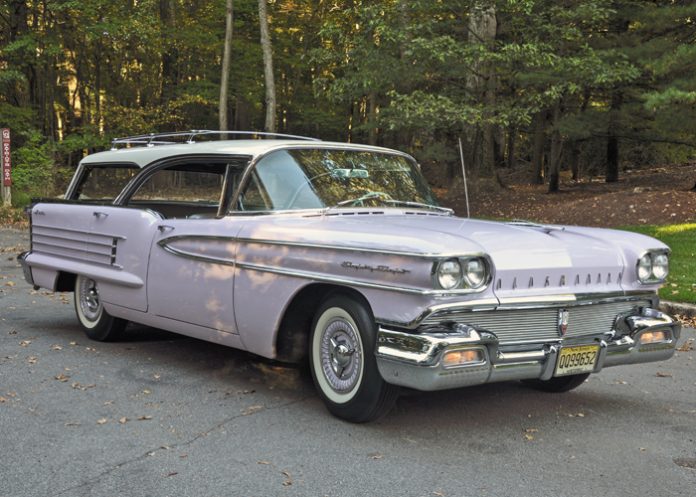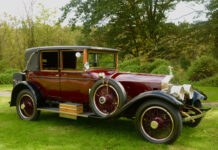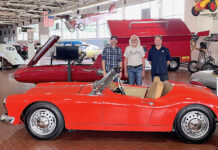By Jay Hirsch
The 1958 Oldsmobile was the “King of Chrome” in the height of the American Car Chrome Age. All that chrome is deceiving, in that the 1958 Olds appears to be longer than the very clean looking (as in minimal chrome) 1957 Oldsmobile. The 1957 and 1969 Olds are the same length with the 88 series, being 208.2 inches long and the 98 series 216.7 in length. The new-for-1958 dual headlights set off by the side chrome spear that extends into the passenger helped add to the illusion of great length.
Post-WWII 1950s America was a time of prosperity and peace. The suburbs were spreading, business was expanding and Americans could not get enough of those newly-designed cars coming out of Detroit. The cars were tailored to their lives…comfort and extra size were part of that life. Bjg engines were part of that car life as those engines enabled people to cruise the new interstate highways at speeds of 65 to 75 mph for hours on end to see parts of this great land.
There were three series Oldsmobiles for 1958, the Dynamic 88, Super 88 and the top of the line 98. The difference between the Dynamic 88 and Super 88 was that Super 88 had some more chrome trim than the 88. The Dynamic 88 series is “understated” in comparison to the Super 88. Another more recognizable difference is in the rear where the back-up lights are located. In the Super 88 and the 98 the back-up lights are inset into the bumper ends under what was the back-up light on the Dynamic 88. There is another tall light in the area where that back-up light was.
The gas fill is on the top of the tall light housing, hidden, as in Cadillac’s from 1941 to 1958, in the driver’s side tall light — and the same for 1956–1957 Chevy.
After WWII, as Americans moved to the suburbs, the station wagon grew in popularity. The “new technology” of all-steel bodies, as opposed to the wooden bodied pre-WWII, was influential in this rapid growth of the station wagon in the 1950s. While wood may have been attractive, it required much upkeep. In the winter the wood shrank, creating drafts, and in the summer when the wood swelled, the opening and closing of doors was difficult.
As the popularity of the station wagaon grew in the late 1950s, so did the popularity of the hardtop or pillar-less car, in two-door and four-door versions. The first pillar-less American cars to appear were in the two-door Buick and Cadillac in 1949 and were referred to as “hardtop convertibles,” for with all four windows down there was the feeling and look of a convertible. This look was introduced in the American four-door car in 1955. In 1956 Rambler had a pillar-less wagon, and in 1957 Buick and Oldsmobile brought out their versions. The Buick model was called the Caballero, and the Olds was named the Fiesta.
The price of the Fiesta 88 was $3,623, and the price of the Fiesta Super 88 was $3,895. The top of the line 98 four-door hardtops was $4,100, and the 98 convertible was $4,200. The Fiesta was not an inexpensive automobile! All Fiesta’s rode on 8.50 x 14, as did the Olds 98. Among the many options was the “transportable-radio.” This was a transistorized radio that could slide out of the dashboard and be taken with you to listen to music. There was a lock to prevent anyone from taking the “transportable radio” from the car. This was in the “pre-historic” days before iPods and smart phones. The few computers that were on the scene were the size of a room and punched out information on paper cards.
Computers aside, your Olds Fiesta could have had air conditioning, power steering, power brakes power windows, automatic transmission, power seat, power antenna for that radio, and a host of other options which you did not have to order “in a package.”
Seat belts were one of those options that the car-buying public at the time did not embrace. The general feeling was that if the car is made well and is safe, why does one need a seat belt?
A performance option introduced in 1957 and carried on into 1958 was the J-2 Rocket engine option. This was 3-2- bbls carburetors. The engine for all 1958 Oldsmobile’s was the OHV 371 cid V-8/6 liter. Air suspension was an option that enabled the driver to raise the car four inches above its normal road clearance height of six inches for off road clearance or lower the car for highway cruising. The early air suspensions were a costly option and some units did have problems. In 1959 Olds no longer would offer air suspension,
The Olds Fiesta seen here in Heather and White has undergone a minor cosmetic restoration by its owner, Joe Carfagna. Joe likes all American cars from the 1950s and 1960s, and station wagons in particular. This Fiesta was in the same family since new for over 50 years and was always used for pleasure driving, not as a business vehicle.
“The original owner liked the look and ride of the Fiesta and never got tired of seeing it and driving the wagon,” Joe said. “By the late 1960s it was an attention-getter, and he decided this car was a keeper,”
The car was always garaged and never smoked in. The original owner’s son and daughter shared in keeping the car, and by the late 1990s had joined a few car clubs.
It was at a local AACA event that Joe saw the Fiesta and asked if they ever considered selling it. They said “not at this time,” and Joe and the son exchanged phone numbers. It was in 2006 at the same AACA event that Joe saw the car again and this time the son and daughter, who had grown children of their own, told Joe “it is time to sell.”
Even though the car was garaged, the Heather paint was slightly faded. Joe decided to have the Heather portion of the car repainted. Joe had seat belts installed and added the roof rack that he found through a club for station wagon owners. The interior is original, and the motor has never needed any major work. Joe replaced the points with a Petronix unit.
As for the ride…it is rock solid. The workmanship that went into the Olds is evident when starting the car and shifting into drive. The car rides smooth but not pillowy or soft. It is a firm ride, and the Olds handles curves more like a 1980s or later car. You sit upright, as in a “Morris chair,” with feet hanging down naturally rather than stretched out flat. After riding for an hour or more this fact is much appreciated.
In the 1958 Oldsmobile sales catalog the opening page the word “OLDSmobility” is used: “It is more than a word. It is a completely new way of going places in this modern era. Fresh new design….revolutionary engineering….and a new experience in riding comfort.” •



